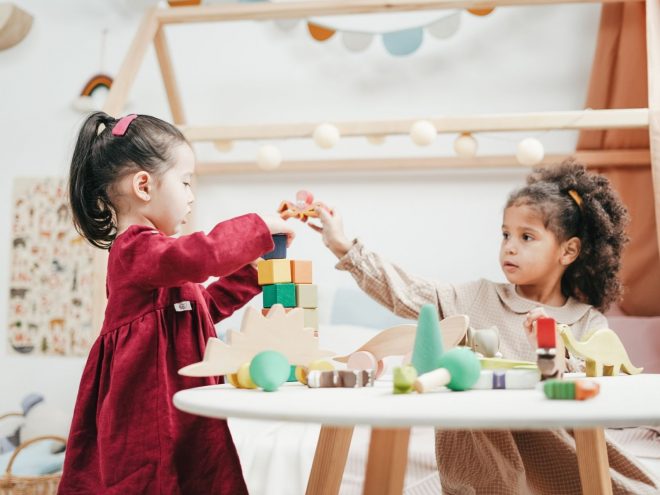Babies learn to recognize your voice early on. It can comfort and soothe them when they are fussy or afraid. Somewhere between the age of five and seven months, babies understand the sound of their name and that it refers to them. It’s natural for them to match sounds with objects, including themselves. If you practice showing them objects and saying what they are, this will speed up the process. Use something simple, like a ball (not something crazy like a xylophone). Say “ball” as you show your baby. You can do the same with their bottle, and if that’s their food source, they will learn quickly. Using their name along with it continues to help them recognize you’re talking to them. In about six months they will be responding to you in their own language—coos, gurgles and other outbursts of sound. They are learning and putting what they learn into practice. In ten to twelve months you will start hearing words or at least sounds that sound like words. It’s a magical moment when you hear them say something intelligible for the first time. You know what they are saying, and they know you know too. As they grow into their toddler years, they will discover many other things beyond language. They will know their name, but they might not respond to it when you want them to. They might be too busy running away. It’s important you keep practicing with them as best you can. Try some of these name recognition tips and games with your toddler to ensure they learn their name, others’ names and, eventually, how to spell them.
Big Bold Letters
Make cut-outs of your child’s name in large, colorful construction paper letters. Focus on the first letter of their name. “Tommy starts with T.” Gradually start adding the rest of the letters. Don’t be frustrated if it takes them a while to remember the exact order, especially if they have a long name.
Name Tags
When in a group setting, help each child make a colorful name tag for themselves. If the kids already know each other’s names have them say another child’s name while pointing to the name tag. Soon they will learn to identify the word with the child. If they don’t know each other, it might take longer to associate names with words, but it will still be effective. You can also play name tags on cubbies, lockers, desks and coat hooks. It might be helpful to put a picture of the child with the name to make association easier. After a few months, remove the image, and you’ll likely see the kids still know whose spot is whose.
Practice the Alphabet
This is a classic building block of learning to read and write. Use flash cards, figurines or blow-ups shaped like alphabet letters or any letter art projects to capture the children’s attention. Have each child find the letter that starts their name. Julie will always remember the letter J.
Find Your Name
Design colorful, laminated name signs for each child. Mix them all up in a big pile and encourage the children to find their own name. Some kids will be able to find their own and everyone else’s, so try to encourage the kids to work on their own name only at first. Play “name hide and seek.” Have the children close their eyes while you hide their name signs throughout the classroom. Yes, they are going to peek, so turn the name signs upside down until you find their appropriate hiding place. Play “hotter-colder” if some children are taking too long to find theirs.
Saying and Spelling Names
Start your morning by having the children sit together in a circle on a carpet or play mat. Have the group say “good morning” to each child by saying and spelling their name. “Good morning, Kelly! K-E-L-L-Y” and so forth. You will find the children might start calling each other by their spelled name just for fun. They are actually learning while playing.
Name Scramble
At home, you can use refrigerator magnets, sticky notes, painted rocks, clothespins or any other item that gets your child’s attention. Paint, color or identity in some other way the items you are using with each letter of your child’s name. Have your child practice putting the letters in order while sounding out their name. The first letter will always be the easiest. The ones in the middle tend to be confusing for your child, especially if their name contains irregular sounds. Don’t let them get too discouraged. If your child is stuck on a letter, have them sound it out, then put it in place for them. This will eventually help them get the next letter and have more success in following tries. The letter magnets are nice because you can use them to learn many more words than just their name. And you won’t have to paint multiple versions of the alphabet on rocks or clothespins. Be patient and encouraging when teaching your toddler how to recognize and spell their name. Some pick it up quickly. Others take a long time. It can be frustrating for them. They want to learn, and they want to make you happy. Make name recognition a fun part of their daily learning.





